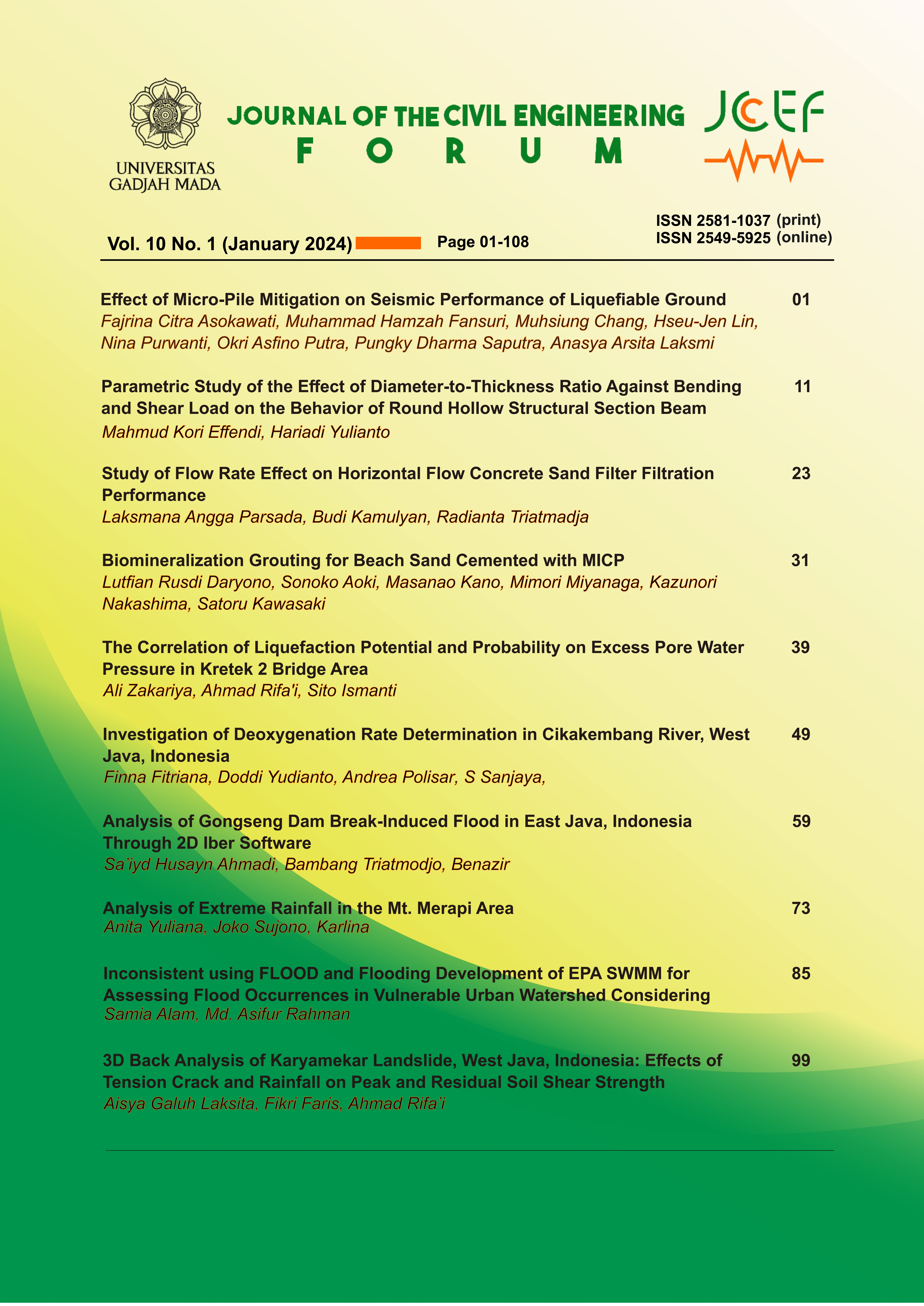Biomineralization Grouting for Beach Sand Cemented with MICP
Abstract
Microbial-induced carbonate precipitation (MICP) is an environmentally friendly approach that relies on the production of calcium carbonate by microorganisms to construct or reinforce coastal structures. In order to address the disadvantages of current coastal countermeasures techniques, MICP is a cost-effective solution that can be used to repair and restore coastal habitats damaged by human activities. The resulting structures formed through MICP are strong and durable, providing long-term protection against erosion and flooding caused by storms or rising sea levels. Biominerals, including calcium carbonate or calcium phosphate, are used to create complex composites with organic molecules by combining the strength of inorganic materials with the versatility and biocompatibility of organic macromolecules. It is of the utmost importance to investigate
the functionality of MICP and scale up its deployment in various fields in order to thoroughly assess the instrument’s application. Coastal erosion has been a severe concern in archipelagic countries. Therefore, this study explored the Miyazaki coast in Japan and the Yogyakarta coastline in Indonesia to minimize coastal erosion using MICP. The bacteria found in Miyazaki (Sporosarcina species) and the Yogyakarta coast (Pseudoalteromonas tetradonis) were used in the experiment. As a result, the sample treated with a gradual injection of the cementation solution achieved about 6 MPa UCS after 21 days of treatment. The objective were investigated the potential biotreatment with original sand materials and to evaluate the long-term durability under saturated conditions. For these purposes, the MICP-treated sand columns were subjected to series of compression tests and wet-drying (WD) durability analysis.
References
Adger, W. N., Hughes, T. P., Folke, C., Carpenter, S. R. and Rockstrom, J. (2005), ‘Socialecological resilience to coastal disasters’, Science 309(5737), 1036–1039.
Anbu, P., Kang, C.-H., Shin, Y.-J. and So, J.-S. (2016), ‘Formations of calcium carbonate minerals by bacteria and its multiple applications’, Springerplus 5(1), 1–26.
Cheng, L., Shahin, M. A. and Mujah, D. (2017), ‘Influence of key environmental conditions on microbially induced cementation for soil stabilization’, Journal of Geotechnical and Geoenvironmental Engineering 143(1), 04016083.
Ciantia, M. O., Castellanza, R., Crosta, G. B. and Hueckel, T. (2015), ‘Effects of mineral suspension and dissolution on strength and compressibility of soft carbonate rocks’, Engineering Geology 184, 1–18.
Daryono et al. (2020a), ‘Investigation of natural beachrock and physical–mechanical comparison with artificial beachrock induced by micp as a protective measure against beach erosion at Yogyakarta, Indonesia’, Geosciences 10(4), 143.
Daryono et al. (2020b), ‘Sediment characteristics of beachrock: A baseline investigation based on microbial induced carbonate precipitation at Krakal-Sadranan beach, Yogyakarta, Indonesia’, 10(2), 520.
DeJong, J. T., Mortensen, B. M., Martinez, B. C. and Nelson, D. C. (2010), ‘Bio-mediated soil improvement’, Ecological Engineering 36(2), 197–210.
e Portugal, C. R. M., Fonyo, C., Machado, C. C., Meganck, R. and Jarvis, T. (2020), ‘Microbiologically induced calcite precipitation biocementation, green alternative for roads–is this the breakthrough? a critical review’, Journal of Cleaner Production 262, 121372.
Feng, K., Montoya, B. M. and Evans, T. M. (2017), ‘Discrete element method simulations of bio-cemented sands’, Computers and Geotechnics 85, 139–150.
Gowthaman, S., Nakashima, K. and Kawasaki, S. (2020), ‘Freeze-thaw durability and shear responses of cemented slope soil treated by microbial induced carbonate precipitation’, Soils and Foundations 60(4), 840–855.
Gowthaman, S., Nakashima, K. and Kawasaki, S. (2022), ‘Effect of wetting and drying cycles on the durability of bio-cemented soil of expressway slope’, 19(4), 2309–2322.
Kalkan, E. (2020), ‘A review on the microbial induced carbonate precipitation micp for soil stabilization’, International Journal of Earth Sciences Knowledge and Applications 2(1), 38–47.
Li, Y., Shi, T., Li, Y., Bai, W. and Lin, H. (2019), ‘Damage of magnesium potassium phosphate cement under dry and wet cycles and sulfate attack’, Construction and Building Materials 210, 111–117.
Mortensen, B., Haber, M., DeJong, J., Caslake, L. and Nelson, D. (2011), ‘Effects of environmental factors on microbial induced calcium carbonate precipitation’, Journal of applied microbiology 111(2), 338–349.
Pilkey, O. H. and Cooper, J. A. G. (2014), ‘Are natural beaches facing extinction?’, Journal of Coastal Research (70), 431–436.
Pörtner, H. O., Roberts, D. C., Tignor, M., Poloczanska, E. S., Mintenbeck, K., Alegría, A., Craig, M., Langsdorf, S., Löschke, S., Möller, V., Okem, A. and Rama, B. (2023), ‘Summary for policy makers. in: Climate change 2022: Impacts, adaptation and vulnerability’, Ocean and Coastal Management 235, 106487.
Rangel-Buitrago, N., Williams, A. T. and Anfuso, G. (2018), ‘Hard protection structures as a principal coastal erosion management strategy along the caribbean coast of colombia. a chronicle of pitfalls’, Ocean & Coastal Management 156, 58–75.
United Nations (2022), ‘Global issues: Population’. Available in un.org/en/global-issues/population.
Whiffin, V. S., Van Paassen, L. A. and Harkes, M. P. (2007), ‘Microbial carbonate precipitation as a soil improvement technique’, Geomicrobiology Journal 24(5), 417–423.
Zhao, Z., Yang, J., Zhang, D. and Peng, H. (2017), ‘Effects of wetting and cyclic wetting–drying on tensile strength of sandstone with a low clay mineral content’, Rock Mechanics and Rock Engineering 50, 485–491.
Copyright (c) 2024 The Author(s)

This work is licensed under a Creative Commons Attribution-ShareAlike 4.0 International License.
Copyright is granted to authors for the purpose of providing protection for articles written to describe experiments and their results. JCEF will protect and defend the work and reputation of the author and are also willing to address any allegations of violation, plagiarism, fraud, etc. against articles written and published by JCEF. JCEF is published under the terms of the Creative Commons Attribution-ShareAlike 4.0 International License (CC BY-SA 4.0). The author holds the copyright and assigns the journal rights to the first publication (online and print) of the work simultaneously.






